Article and photos by Joe Mish
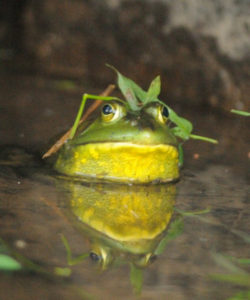
Areas which flood each spring are called vernal pools and attract several species of frogs. Each species produces a distinctive call, all in an effort to attract a mate. The orchestral performance this spring night was provided by spring peepers, pickerel frogs, green frogs and American toads. This green frog wears the equivalent of a lamp shade on his head after a night of froggy frolic.
The moon would not be full until the next night, though the difference could not be told without a lunar calendar. As the moon rose above the horizon it was shrouded in low clouds and tinted orange by the earth’s atmosphere. The moon appeared as if hiding behind a shear white veil, drawing more attention and holding a glance until it became a stare.
From the highpoint above the river, the first full view of the moon rising thru the thin white haze was screened by a loose weave of fine treetop branches. The delicate stems stood out in sharp contrast against the brilliant orb and moonlit clouds.
A tall cherry tree, growing out of a line of dark pines on a low ridge parallel to the river, perfectly balanced the moonlit scene with a staircase of blossoms turned luminous in the rising light.
A landscape painter could ask for no better inspiration than presented on this spring evening.
The overgrown path to the river was paved with fragments of white flowers from the blooming thornapple trees. The small round petals took on a glow in the rising moonlight to mark the trail, making it easier to follow.
A chipping sparrow, out later than it should have, hung onto a stem of tall amber broomsedge grass, as if it were a pole vaulter, caught in midair, hanging on to a pole at maximum flex.
The slow moonrise was reversed, as the trail to the river descended and hid the moon below the horizon.
Before the full moon reaches its zenith, visibility is lost in a temporary moment of deepening darkness, though a sense of night time vision may be provided by listening to the sounds of nature.
The call of geese from the river vibrated through the darkness to dominate the night. Their conversation was even and constant as they settled in for the night.
Their calls would pick up in response to late arriving flights validating a safe harbor below.
At night, geese dispense with circling and come right in with wings set and feet outstretched for touchdown. The sound of geese landing on water at night is a gentle extended, woosh, as their feet skim the water’s surface to slow the landing speed, followed by a barely perceptible splash.
The wind whistling through the primary feathers on birds wings, makes an odd creaking sound to betray their otherwise invisible night time approach. Straggling flocks of common mergansers and wood ducks landed parallel to the shoreline, mid river, and then dispersed to spend the night on the water in some eddy or quiet water below a fallen tree.
When the moon rose high enough to shed its gossamer haze to float above any earthbound obstruction, the moonlight intensified and now reflected on the river. Each ripple appearing as a silvery diamond. The ducks and geese became silhouettes as they drifted across a bejeweled stream of silvery light as viewed from opposite the light source.
Occasionally a call from an unidentified bird could be heard among the intermittent wood duck whistling and goose banter. The calls generated speculation, perhaps a black or yellow crowned night heron or just an irritated great blue heron.
The steady drone of spring peepers went nearly unnoticed as white noise, as it was separated from the sounds along the river by a good quarter mile. When attention was focused on the spring peepers which dominated the vernal pools, the solo calls of competing pickerel and green frogs could be heard. Focusing on sounds in the night, coming from opposite directions, was like simultaneously listening to two radio broadcasts; each source competing for attention.
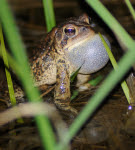
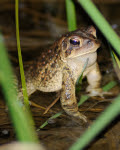
American toad
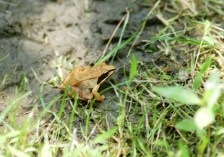
carpenter frog, alias wood frog
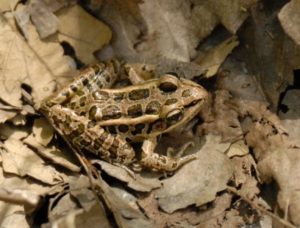
pickerel frog
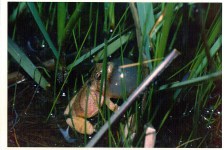
spring peeper/hyla crucifer
Author Joe Mish has been running wild in New Jersey since childhood when he found ways to escape his mother’s watchful eyes. He continues to trek the swamps, rivers and thickets seeking to share, with the residents and visitors, all of the state’s natural beauty hidden within full view. To read more of his writing and view more of his gorgeous photographs visit Winter Bear Rising, his wordpress blog. Joe’s series “Nature on the Raritan, Hidden in Plain View” runs monthly as part of the LRWP “Voices of the Watershed” series. Writing and photos used with permission from the author.
Article and photos by Joe Mish
RAINFALL: It rained about 2.5 inches in the New Brunswick-Trenton area at the end of last week. So, it will be interesting to see what this week’s drought maps say.
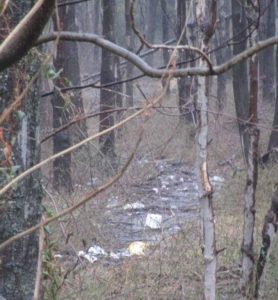
Garbage floating in a Monroe, Middlesex County, drainage ditch
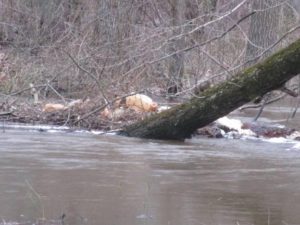
Garbage caught on a tree snag
in Manalapan Brook, Monroe, Middlesex County
NON-POINT SOURCE POLLUTION: During and after the week’s rains, the flow of non-point source pollution was obvious in our waterways. The cost-free way of dealing with it is, do not litter and do not leave stuff out in the yard, then it will not float into waterways.
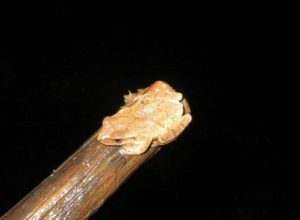
A spring peeper treefrog, found in the Manalapan Brook floodplain
FROGS: I walked into the swamp hardwood forest of the Manalapan Brook floodplain between Helmetta and Jamesburg early in the week. The sleigh bells-like sound of spring peeper treefrogs, “Pseudacris crucifer crucifer,” was obvious. I also heard monkey chattering-like sound of wood frogs, “Rana sylvatica.”
RASPBERRIES: I planted five bare-root Burpee seed company Caroline raspberry plants.
GARDEN ZONES: Depending on the source, the area is Garden Zone 6 (cooler) to Garden Zone 7 (warmer). That means our last frost generally is April 15 to 30; Our first frost is generally Oct. 11 to 20. Beyond that, I am playing it safe and sticking with Zone 6 for my Helmetta area, Middlesex County, home, although the area becoming a solid Zone 7 because of global warming is likely just around the corner.
OUTDOOR PLANTING FOR SUMMER VEGETABLES AND FRUITS: My rule of thumb is May 20 if it is a warm to normal and, if it is cooler, wait to June 1.
PREPARING PLANTS INDOOR: This year, though, I am trying something new, sowing plants indoors before the outside plant dates. So, I am experimenting with Kaleidoscope Blend Organic and Touchon carrots, Iceberg A lettuce, and Sugar Snap peas, all Burpee, which I began sowing about March 5. I added Rutgers tomatoes about March 25. I plan on sowing more tomatoes – Brandywine Red and Red Cherry, both Lake Valley brand – indoors in the next day or so.
HUMMINGBIRDS: Get the hummingbird feeders up by about April 15 to attract the early “scout” birds and they hopefully will lead later-arriving hummingbirds to the feeders.
NIGHT SKY: http://www.skyandtelescope.com/observing/sky-at-a-glance/this-weeks-sky-at-a-glance-march-31-april-8/.
SUNRISE/SUNSET: Approximate times are April 2, Sunday, 6:40 and 7:23 Eastern Daylight Time; April 3, Monday, 6:38 and 7:25; April 4, Tuesday, 6:36 and 7:26; April 5, Wednesday, 6:35 and 7:27; April 6, Thursday, 6:33 and 7:28[ April 7, Friday, 6:31 and 7:29; an April 8, Saturday, 6:30 and 7:30.
WEATHER: Local weather forecasts are available at http://www.weather.gov/phi/.

Carnegie Lake near the Kingston dam
on the boundary of Mercer, Middlesex, and Somerset counties
Joe Sapia, 60-years-old, grew up and lives in the Pine Barrens around Helmetta, where his family has resided for more than 100 years. He can be reached at Snufftin@aol.com or at P.O. Box 275, Helmetta, 08828.
The LRWP, coLAB Arts and the Raritan Headwaters Association are co-hosting a special Earth Day clean-up of New Brunswick’s waterfront on Saturday April 22.
Please park in the New Brunswick Landing Parking Lot, located at the crossroads of Route 18 and New Street (see directions below). There will be signs up to direct folks to the clean-up site, where there will be a table set up with sign-in forms, bags, gloves, etc.
Volunteers should dress for the weather, and be prepared to be outdoors.
Driving Directions:
From Route 1 :
• Take Route 18 North
• Pass through the first light at Paulus Boulevard
• STAY TO THE RIGHT after this light Follow signs towards New Brunswick Exits/Route 27
• Continue through two (2) traffic lights (DO NOT TURN AT THE SIGN FOR BOYD PARK)
• Pass under New Street
• Make the first right into the New Brunswick Landing – ENTRANCE IS BEFORE THE EXIT FOR ROUTE 27 NORTH/HIGHLAND PARK
From New Jersey Turnpike:
• Take the NJ Turnpike to Exit 9 (New Brunswick)
• Follow directions for Route 1
Article and photos by Francisco Gomez, Founder and Director of Raíces Cultural Center, a non-profit organization dedicated to preserving cultural roots through the arts, history and ecology.
With many thanks to Francisco and the Raíces Cultural Center for joining us for our February 25 clean-up of the Raritan River floodplain in Piscataway.
We headed out for Johnson Park last Saturday for a river clean-up of the Raritan. There were about a dozen people gathered as we were given our trash bags and long reach garbage grabbers to tackle the debris.
I often take my daily walks along the river, especially during the Spring and Summer. There’s always been something special about the water, as polluted as it is, wildlife and the people that are out doing what I do to get my daily dose of Nature.
Having walked the river ever since I was a kid, and let me say many moons have passed since then; I have witnessed the gradual environmental destruction of this once great water way.
As a child growing up in Perth Amboy, I would hangout on Mechanic St. with my friends. We would walk to the waterfront and dive off of a dock at the end of Buckingham Ave., adjacent to the Chevron Oil Refinery. At the end of the dock there was moored an old World War 2 mine sweeper that we would explore when we weren’t swimming in the entrance to the Arthur Kill and across the Raritan Bay to Staten Island. That was the early 1960’s and the water was still good enough to swim. At some point in 1961 we noticed oil spots on our skin when we came out of the water, and we reeked of petroleum. Needless to say, we stopped swimming in the bay and that wonderful part of our childhood came to an unwanted end. It would be many years later, when I became involved in the environmental movement, that I fully understood the negative impact of what corporate greed and indifference to Mother Nature had done and is still doing.
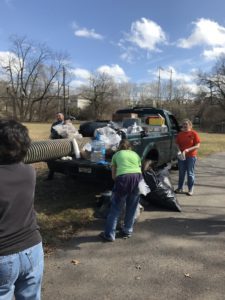
As our crew scoped out the coast line for garbage, a sudden sadness and anger overwhelmed me at the same time. It brought to mind a commercial clip made back in the early 1970’s of a First Nation’s man who rows down a river in a canoe, and as he gets into the greater water way he begins to see the incredible amount of garbage thrown into the river by humans. He also sees all the petrochemical companies spewing toxic waste from their chimney stacks and the pipelines from their factories that drain into the bay. When he gets out of his canoe by a highway, one of the cars passing by tosses a bag of fast food that lands at his feet. As he turns towards the camera you see a tear roll down his cheek. The actor’s name is Iron Eyes Cody, but what he was seeing was no act!
As we continued our sweep of the coastline I understood fully what our disregard and disrespect for Nature has produced. Just attempting to clean-up the vast amount of debris in one minuscule patch of river line was daunting and seemed totally futile; I believe this is what made me so angry. I know that I’m not without blame, for I have also contributed to this catastrophe in one way or another, directly or through the forced machinations of the corporate Matrix.
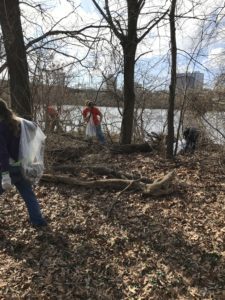
Enter the Lower Raritan Watershed Partnership. This is the organization who coordinated the river clean-up and does the remarkable work of attempting to protect the Raritan River. These guys do everything from stewardship, civic science and environmental monitoring, habitat and ecological health, Eco-art and, of course, lots of clean-ups.
Two hours later we had collected a number of bags filled with trash, a bicycle, one or two huge plastic tubes and a very heavy corroded metal lid. The truth is we barely made a dent in our clean-up.
Volunteering to be part of these clean-ups can be quite disheartening and almost pointless because of the amount of new trash that is dispensed onto the landscape and into the river each day. However, one should not be deterred from joining in to do this most important work. There is some recompense in watching a jogger or cyclist pass by, smile and thank us for collecting what seems to be a very small amount of garbage. There is satisfaction in cleaning up other people’s carbon footprints, even if you may not believe so.
So if you’re so inclined and want to do your part to make the environment a little more ecologically balanced, then come out on one of the workdays and get a little dirty so we can make the Raritan River a little cleaner again – you won’t regret it!
Article and photos by Joe Mish

A juvenile myrtle warbler searches the ice shrouded shoreline of the South Branch in late February
February is midwinter’s better half, given it is two days shorter than any other month and two days closer to spring, a virtual, ‘get out of winter free, card’. The significance of those two missing days provides a powerful psychological boost to soothe winter doldrums and seasonal affective disorder accumulating since December.
Although spring is the ‘finish line’ for surviving winter, the early days of spring are often indistinguishable from winter weather. This demonstrates that our characterization of the seasons is based more on legend than reality, especially when a lingering winter feels like an eternity.
Moving from impressionable feelings and missing days to more tangible evidence, February provides many visual clues that spring is around the corner. Its 28 days are a prelude or appetizer, stirring the emotions, building anticipation for the main event, the first day of spring.
To see visual clues we need light and light is what February delivers. In 28 short days we gain about an hour of day length, most evident to causal observers by noting the later time of sunset.
The increasing day length triggers a response in people and animals as we see the start of bird migration, courtship, flowers and tree buds.
Bird migration is one of the most colorful visual cues that winter has run its course. The milder the winter the earlier migration begins. Migration may be local, as with bluebirds or two thousand of miles away for many of the colorful warblers.
Late February usually marks the very beginnings of small bird migration north. Our rivers, streams coastlines and even interstate roadways provide linear pathways for migrating birds. The most colorful and plentiful are the myriad of warbler varieties. It is not unusual to see a bright flash of color darting along the riverside in late February despite shoreline ice and cold weather. A band of north bound travelers may find temporary shelter during a cold spell on south facing hillsides or in brush along steep river banks, protected from the wind and saturated with full sun.
Hawks are usually seen now in pairs as they bond prior to nesting. The owls hooting on cold winter nights and local bald eagles may well be incubating eggs.
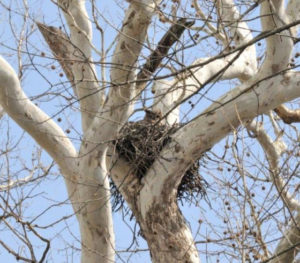
Great horned owl nesting in am old red tailed hawk nest
Muskrat, mink and fox are out and about in a courting mood. This is the time to scan fields for red fox roaming the countryside looking for mates. Love is definitely in the air.
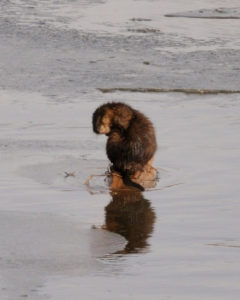
Muskrats are more often seen during their late winter early/ spring courting season
Male white-tailed deer have dropped their antlers and females are heavy with fawns as day length triggers hormonal changes to alter behavior and ensure best chances for winter survival. Now is a good time to walk the fields and woodlots to look for dropped antlers.
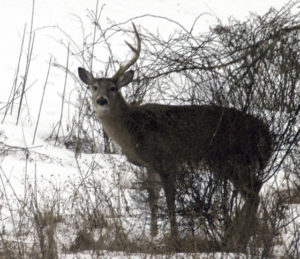
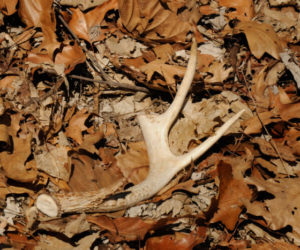
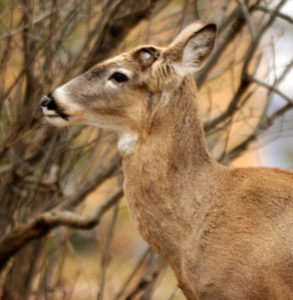
A buck has dropped one antler, the other will soon drop perhaps when it jumps a fence. A dropped antler charcterized by an irregular base. Antler buds after the antlers drop. Within a couple of months, the antlers will begin to sprout from these buds surrounded by viable tissue with a velvety appearance that readily bleeds if injured.

The first and most consistent sign of spring for me is the blooming of snowdrops, en masse on a hillside, near where I usually launch my canoe on the South Branch. As cold as it might be, the sight of those tiny white flowers gives me inspiration, fires my energy and issues a solemn promise of the return of spring.
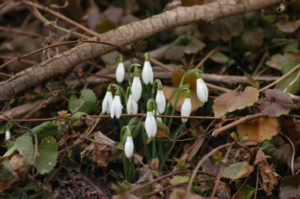
A patch of snow drops blooming midwinter heralds the return of spring
By February, the deep red leaf buds, on the trees that line the river, stand out against brown and gray interlaced branches. When viewed at a distance, the contrasting colors are enhanced as they take on a solid appearance as if created by long horizontal brush strokes in a painting.
A full moon will occur on February 11th to light up the night, as a compliment to the lengthening daylight, to make February a well lit marquee announcing next month’s arrival of spring.
Author Joe Mish has been running wild in New Jersey since childhood when he found ways to escape his mother’s watchful eyes. He continues to trek the swamps, rivers and thickets seeking to share, with the residents and visitors, all of the state’s natural beauty hidden within full view. To read more of his writing and view more of his gorgeous photographs visit Winter Bear Rising, his wordpress blog. Joe’s series “Nature on the Raritan, Hidden in Plain View” runs monthly as part of the LRWP “Voices of the Watershed” series. Writing and photos used with permission from the author.
Photos and Article by Joseph Sapia
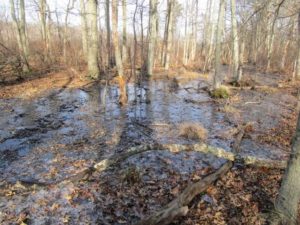
A pond at Szeliga’s Orchard
On this near-to-Christmas day, I was without my Jeep, which was in the shop for most of the day for routine, but time-consuming, maintenance. Without a vehicle, I was living life by foot – walking a mile or so to lunch at the old general store in Helmetta and picking up my mail from my third-generation Post Office box next-door. The walk was to be pragramtic, rather than playful, although I chose a route skirting the woods, instead of walking the Main Road directly from my neighborhood.
After 60 years of living and about 40 years as a journalist, I should know, Be ready for what is out there, unexpected or not. As a woodsman here in the Pine Barrens around Helmetta since old enough, I should know, A walk is not simply a walk.
So, I was glad I put my camera in my pocket.
Before I even left the neighborhood, I came upon a cluster of holly, thick with leaves and holding many berries. A Christmas treat – and my first photographs.
After about three blocks, I went afield, getting on the Pipeline, then onto the freight railroad tracks. Almost immediately on the tracks, I saw a dead mouse lying on a tie between the rails . A victim of a hawk or fox or some other cause of death? I do not know, but another photograph.
As I walked the tracks north, toward Helmetta, I noticed two species of pine: pitch, with its long, swirled needles in clusters of three, along with Virginia, with short, swirling needles in clusters of two. Their green contrasted nicely against the clear, blue sky.
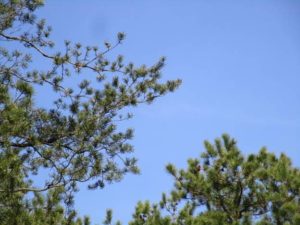
Virginia pine to the left, pitch pine to the right
After crossing Saw Mill Brook, I noticed a third pine in the old Szeliga’s Orchard: white, with supple needles in clusters of five. The species being easy to remember with its five needles, or W-H-I-T-E. It is not a native, here. This was probably an escape from nearby houses.
In the old orchard, I saw ground pine, or Lycopodium. Also, there was a nice little pond – I knew of the swamp, here, but did not remember this much ponding. And there was a fallen tree trunk, pecked by a woodpecker or woodpeckers.
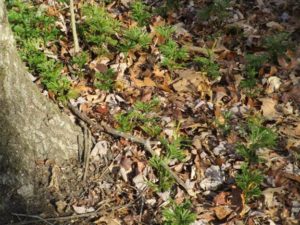
Ground pine at Szeliga’s Orchard
I got to the former worker homes of the George W. Helme Snuff Mill — which ceased production in 1993 and, this year, opened as apartments — and cut through the alley dividing them. After a visit to the Post Office and lunch at the store, I walked to Helmetta Pond.
There, I found a thin layer of ice along the shore – the temperature was now in the low 40s, but overnight it had got down to about 30. Canada geese sat in the pond on its other side by the woods. There, it was a mix of pines on the high ground, swamp hardwoods and Atlantic white cedar in the wetlands – and, it seemed, more and more invasive Phragmites reed grass.
On the way back, I took photos of ice in a ditch and Shekiro’s Pond, which had a cluster of punks, or cat-tails, dying off in the cold weather. Shekiro’s was fending off Phragmites nicely, unlike the Pond to the north and Cranberry Bog to the south.
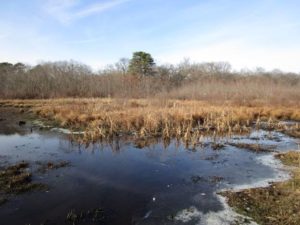
Shekiro’s Pond
At the Bog, I spooked a great blue heron, which took off slowly in flight. But not slowly enough for me to get a photograph. I did stop nearby, though, to shoot a stand of birch on the old Shekiro homestead.
On my way home, I was treated to a ConRail locomotive pulling two hopper cars toward Jamesburg. I snapped photos of the train, glad I had the camera with me over these few hours.
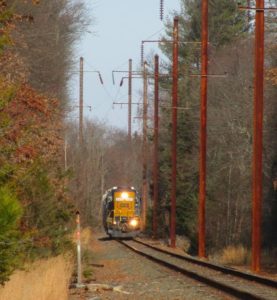
A ConRail train in Helmetta, heading toward Jamesburg
Joe Sapia, 60-years-old, grew up and lives in the Pine Barrens around Helmetta, where his family has resided for more than 100 years. He can be reached at Snufftin@aol.com or at P.O. Box 275, Helmetta, 08828.
Copyright 2016 by Joseph Sapia
Article and photos by Joe Mish
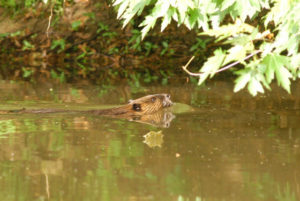
A beaver, whose existence is hidden in plain view, plies the local waters to shatter the belief the area is sanitized of wildlife typically associated with far off wilderness destinations.
As the earth turned its back to the sun on the first evening in January, the rising moon appeared as a thin silver crescent, low on the western horizon.
Just as the moon was high enough to reflect on the mirrored water of the North Branch, its perfect image was disturbed by a series of deep ripples that shattered the image into broken pieces of shimmering light.
The dark night, with minimal light reflected off the moon, made it difficult to see details, though it was clear that the disturbance was made by a beaver.
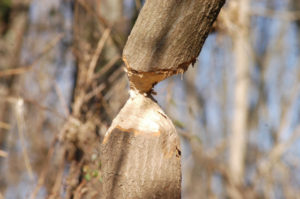
Earlier in the spring I had noticed a small tree cut down, showing unmistakable beaver sign, where a stump is gnawed evenly around, tapering to a perfect point.
For many years, beaver sign along the North and South Branch and Raritan rivers have been commonly seen in the January, February time frame. As the rivers are mostly shallow, the beaver are typically transients heading to the deeper water of the Delaware Raritan Canal or the Millstone to over winter. Many are killed by cars or trapped when they begin to fell trees across the road as was the case in Manville on the D&R canal.
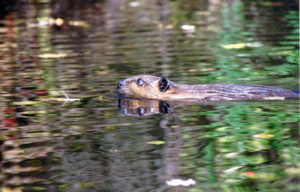
Beaver on the D&R canal built a den and felled trees across the road.
The odd thing about the freshly cut tree I saw, was that it was cut down in April. This was late in the year for a transient beaver. I kept watch all summer and saw no other sign until I noticed wide paths leading from the corn field to the river. The trail was too wide for a muskrat and too muddy for a groundhog. Apparently the beaver was feeding on corn all summer long. No sign of a den was apparent until the fall when the beaver began to cut branches and small trees, piling them at the base of exposed tree roots along a deep section of the river.
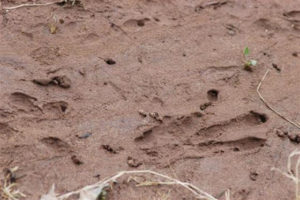
Beaver tracks in the mud along the Raritan River
It was now January, almost 3 months after the corn had been harvested and on this day the corn stubble was dusted with a light snow cover. The thin ice that formed along the banks showed a trail of bubbles made by the beaver as it traveled from its den to stockpile small branches for midwinter dining.
It was interesting to see where muskrats had been under the ice, leaving similar trails of exhaled air bubbles like the beaver, though the beaver left a trail of much larger air bubbles.
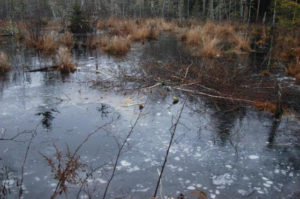
Exhale air from a beaver leaves large bubbles under the ice
Walking along the high bank and mindlessly following a set of fox tracks in the fresh snow, I saw where the beaver came ashore and went a short distance into the empty cornfield. The trail led to a vertical drop down the steep bank, which leveled off and then angled sharply to the right with a quarter turn to the left and directly into the water. It was apparent the beaver slid, rather than climbed back down into the water. A single footprint was evident where it corrected its slippery course.
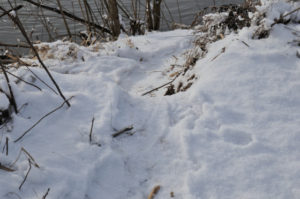
Notice the single footprint to the right side of the trail before the first drop
Further downstream across from the den there was an oak about 10 inches in diameter that the beaver had started to gnaw during the fall and abandoned in favor of several smaller trees 2 to 3 inches thick. That oak was now lying on the ground, a testament to the beaver’s determination, powerful jaws and sharp teeth. It will be interesting to see what the beaver will do with this large fallen tree.
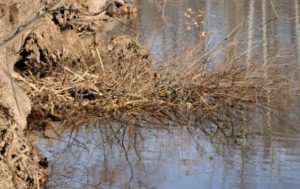
Beginnings of a beaver den or dam.
Beaver have always been associated with the wilderness, their pelts and castor glands served as motivation for French Canadian voyageurs and trappers to open the west after populations were depleted in the east.
To have beaver in our midst is a testimony to the tenacity of wildlife populations long thought erased from existence. It reminds me of Catholic school when the nuns told us to scrunch over in our seats to make room for our guardian angels. In a real sense, beaver are invisible guardian angels of our wild heritage that most people don’t believe exist and never consider.
Author Joe Mish has been running wild in New Jersey since childhood when he found ways to escape his mother’s watchful eyes. He continues to trek the swamps, rivers and thickets seeking to share, with the residents and visitors, all of the state’s natural beauty hidden within full view. To read more of his writing and view more of his gorgeous photographs visit Winter Bear Rising, his wordpress blog. Joe’s series “Nature on the Raritan, Hidden in Plain View” runs monthly as part of the LRWP “Voices of the Watershed” series. Writing and photos used with permission from the author.
Except as noted, article and photos by Joe Mish
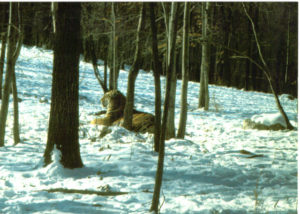
A Siberian tiger, out of place in modern times in New Jersey, comfortably rests on the frozen snow in sub zero temperatures, intensified by a strong northwest wind. Conditions that would turn exposed flesh beet red in an instant, didn’t phase this big cat as it appeared oblivious to the deadly weather; as if not bound by the laws of Nature.
It was a bitter cold day as Bert and I drove the Warner Bros Jungle Habitat trails to check on the open ranging wildlife that occupied the windswept mountains and valleys of the northern New Jersey wildlife park. Inside the warm Chevrolet truck, converted into a veterinary mobile unit, the heater was turned up high, while warm coffee steamed the windshield. Most animals escaped the polar wind hiding behind natural windbreaks and temporary shelters placed around the park.
As we drove past the tiger compound, near the highest point of the park, here was this tiger, a cat we affectionately named, ‘Bobtail’, lying down exposed to the full force of the wind. Bearing an ever present grin, for which the big cats are known, Bobtail appeared content, oblivious to the deadly arctic blast. He remained motionless and stared into the brutal wind that must have escaped from the 10th circle of Dante’s frozen hell, showing no signs of discomfort. He may as well have been enjoying a cool breeze on a warm summer’s day.
This image of Bobtail lying in the snow captures for me the essence of the tiger. Well documented accounts of tigers hunting humans in India, and their magical ability to make kill after kill and avoid inescapable traps, have elevated the tiger to supernatural status.
This is an animal believed to exist in the spirit world as a cunning killer with the ability to transform into flesh and bone and back again at will. The tiger has a reputation of defying natural law that limits all other living things; Bobtail was doing nothing to dispel that myth on this cold day.
The poem, “Tyger”, by William Blake, written in 1794, so well captures the visceral reaction I had to the tigers, I memorized the poem. Here are a few lines that chill my blood.
In what distant deeps or skies Burnt the fire of thine eyes?
And what shoulder, & what art. Could twist the sinews of thy heart?
While here is photographic proof of a tiger living in New Jersey, an anomaly for sure, it is not hard to imagine a time when big cats stalked our land. I wondered every time I passed the tiger compound, how humans ever survived these Paleolithic predators. Perhaps it was the predators’ evolved intelligence that raised the level of human creativity in a Darwinian dance played to a deadly tune.
Evidence of saber tooth cats and jaguars, among other prehistoric creatures, were found in a limestone cave in southeastern PA near Pottstown and trace back to the cretaceous period about 100 to 66 million years ago. The cave was located in a now forgotten town named Port Kennedy, which is part of Valley Forge National Park.
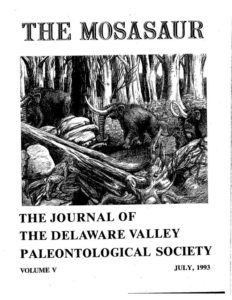
Evidence of sabre-tooth cats of the late cretaceous period discussed in this 1993 article. Additionally fossil remains have been found in the Cutter Clay works near Raritan Bay and along the shore across Raritan Bay in Union Beach.
NJ was unrecognizable in terms of geography and climate with glaciers terminating at the Watchung Mountains and our rivers not yet formed. The Hudson River at one time was thought to have emptied into the lower Raritan watershed at Bound Brook.
As the sea level rose and fell over the eons, it formed clay banks along the Raritan and its bay where dinosaur fossils and tracks have been found. To date, I am not aware of any prehistoric cat trackways or fossils being discovered in NJ. Though surely, when southern NJ was above water, it would be reasonable to expect prehistoric cats, whose remains were found in the Port Kennedy Cave, to have roamed our land.
In more modern times the eastern mountain lion did stalk the shores of the Raritan and in fact a bounty was offered and the last local cat killed in the Sourland Mountains in the early 19th century. Officially, the last New Jersey mountain lions were killed in the southern most counties about that same time.
Rumors of mountain lions persist in several north east states, though no hard evidence has been uncovered in NJ. Given the fact that people have been known to illegally harbor large cats in less than secure enclosures, anything is possible.
Today, New Jersey has a healthy population of bobcats, primarily in the northwest part of the state. The retreating glaciers left a boulder strewn, mountainous landscape with plenty of nooks and crannies, ideal habitat for these elusive felines. Occasionally bobcats are captured on hunters’ trail cameras to give us evidence of their presence as they are rarely ever seen even where they are plentiful.
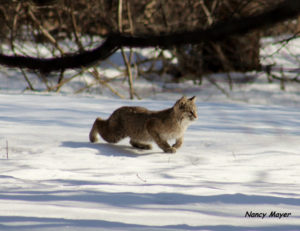
This very rare photo of a bobcat was taken in Warren County, NJ. New Jersey has a healthy bobcat population along with other wildlife thought not to exist within our borders. This cat is really a sabre-tooth tiger distilled down to miniature with all the accumulated intelligence and instincts required for survival in any geologic iteration of New Jersey. Photo by Nancy Mayer
Still the thought of saber-tooth cats, tigers and jaguars ranging across the state becomes more than just imaginary when you see the gleam in your pet cat’s eye. It is as if the prehistoric felines have been distilled down to their essence in the form of modern day cats that dominate many of our homes.
“The Man-Eaters of Kumaon”, by Col Jim Corbett, published in 1944, deals with the man eating tigers of India in the early 20th century. Please read the last chapter, “Just Tigers” before you begin the book as it puts the tiger in perspective and talks about photography vs hunting and concern for their the conservation even at that time. The first hand account of the almost supernatural ability of tigers to avoid being killed or captured while hunting humans, reveals an intellectual battle where man doesn’t always dominate nature.
THE TYGER
By William Blake
Tyger! Tyger! burning bright In the forests of the night, What immortal hand or eye Could frame thy fearful symmetry?
In what distant deeps or skies Burnt the fire of thine eyes? On what wings dare he aspire? What the hand dare sieze the fire?
And what shoulder, & what art. Could twist the sinews of thy heart? And when thy heart began to beat, What dread hand? & what dread feet?
What the hammer? what the chain? In what furnace was thy brain? What the anvil? what dread grasp Dare its deadly terrors clasp?
When the stars threw down their spears, And watered heaven with their tears, Did he smile his work to see? Did he who made the Lamb make thee?
Tyger! Tyger! burning bright In the forests of the night, What immortal hand or eye Dare frame thy fearful symmetry?
1794
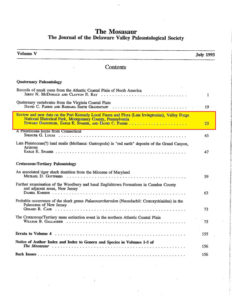
Author Joe Mish has been running wild in New Jersey since childhood when he found ways to escape his mother’s watchful eyes. He continues to trek the swamps, rivers and thickets seeking to share, with the residents and visitors, all of the state’s natural beauty hidden within full view. To read more of his writing and view more of his gorgeous photographs visit Winter Bear Rising, his wordpress blog. Joe’s series “Nature on the Raritan, Hidden in Plain View” runs monthly as part of the LRWP “Voices of the Watershed” series. Writing and photos used with permission from the author.
The LRWP and Middlesex County Parks are co-hosting a clean-up in Piscataway’s Johnson Park on Saturday February 25.
We will meet at 1030 River Road in Piscataway in the lobby of the County Parks Headquarters Office. There will be signs up to direct folks to the office where there will be a table set up with sign-in forms, trail maps for County open space areas, etc.
Volunteers should dress for the weather, and be prepared to be outdoors. Middlesex County will provide gloves and garbage bags. Parking and bathrooms are on-site.
Everything will have died back off the forest floor at this time of the year so it’s a great time to remove refuse – please let us know if you can make it.
The LRWP and Middlesex County Parks are co-hosting a clean-up in Piscataway’s Johnson Park on Saturday January 21.
We will meet at 1030 River Road in Piscataway in the lobby of the County Parks Headquarters Office. There will be signs up to direct folks to the office where there will be a table set up with sign-in forms, trail maps for County open space areas, etc.
Volunteers should dress for the weather, and be prepared to be outdoors. Middlesex County will provide gloves and garbage bags. Parking and bathrooms are on-site.
Everything will have died back off the forest floor at this time of the year so it’s a great time to remove refuse – please let us know if you can make it.




































